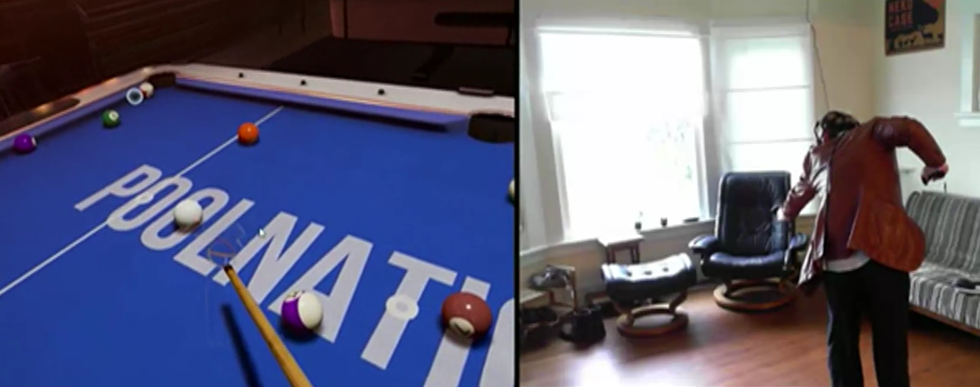
The motion-sports craze has given us approximations of just about every pub game, parlor game, and lawn sport, from darts to bowling to bocce. But one Western real-gaming staple somehow never got a good version during the Wii and Kinect eras: billiards. Wii Play's billiards mode was too limited, while Pool Hall Pro wasn't very convincing in terms of implementing real motion. But, really, how the heck do you translate the physicality of billiards to a home system?
PoolNation VR has an answer, and it comes thanks to its required use of the HTC Vive virtual reality system, as opposed to Oculus or any other option. The $20 game officially launches June 1, but its creators were kind enough to offer Ars a beta key and free reign to post impressions ahead of the launch. So I set up a camera rig, dressed up in my orange, Fight Club-caliber leather jacket (I never leave the house wearing that thing, swear), and cracked open a cold one to simulate the pool-hall experience in my living room. (Watch until the end to see me "pick a fight.")
This video specifically shows how PoolNation VR deals with your inability to lean on a table and physically line up shots. In short, you use both of your hands to get your stick into position, then you hold down the trigger button on your aiming hand to lock your stick's position and angle. A red aiming dot and an optional "ghost" reticule help you line up where the ball will go and whatever English you want to put on your shot.
The largest issue, at this point, comes in the form of the Vive screens' "screen door" blurriness. Pool is one of those games where squinting and lining up your shot is essential. Any lack of detail makes it harder to determine angles and other geometrical considerations before cracking a cue ball. You can walk around (and even through) PoolNation VR's tables to estimate your shot and use your stick to come up with good angles, but once you're behind the ball and aiming, blurriness makes it a wee bit too tricky to tell what angle you're about to hit at. Thus, the current game's ghost-ball boost is damn-near essential.
If that feels like cheating to you, you won't have as good a time with this VR game. Also, we hope PoolNation VR adds some local-multiplayer pass-and-play options before long. Currently, you can only play against other people online. Those issues are a small price to pay for what otherwise adds more physicality and real-life flavor to pool than any video game version I've ever seen, and it's worth noting that an $800 VR system pales in comparison to an actual pool table, both in terms of cost and how much real-life space it takes up in a home. That financial consideration might help you digest the cost of a VR system more easily.
reader comments
19